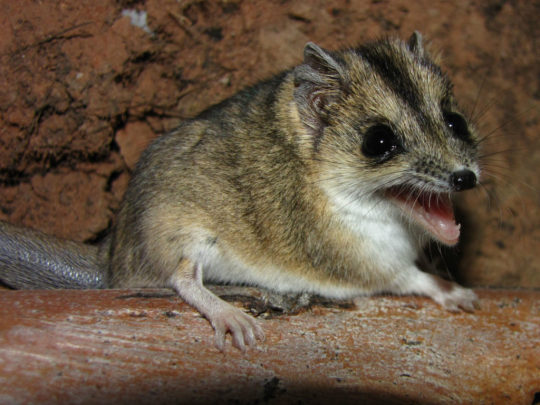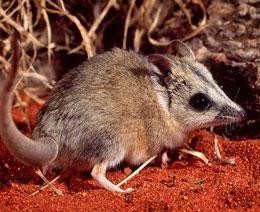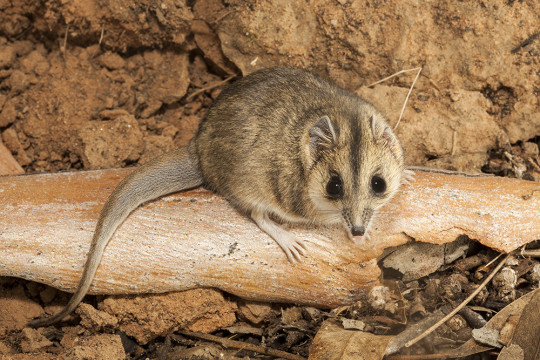#stripe-faced dunnart
Photo



Done In by the Stripe-faced Dunnart
The stripe-faced dunnart (Sminthopsis macroura) is a small mammal found in the dry grasslands and shrublands of Australia. There are three subspecies distributed across the continent; S. m. macroura in central, eastern, and western Australia, S.m. stalkeri in northern Australia, and S.m. froggatti in the Kimberley region. These subspecies diverged from each other millions of years ago, but they bear such a strong resemblance to each other that the distinction was only recently discovered via genetic testing. Although they’re also known as the “marsupial mouse”, S. macroura is not a member of the rodent family. Rather, it’s in a separate family: Dasyuridae, a group of marsupials that also includes quolls (Dasyurus spp.), the Tasmanian devil (Sarcophilus harrisii), and the now-exctinct thylacine (Thylacinus cynocephalus).
S. macroura is one of the smaller marsupial species, at only 15-19 cm (6-7.5 in) long. The tail accounts for nearly half that length. The species is sexually dimorphic, with females usually weighing about 15 g (0.17 oz) and males coming in at 25 g (0.88 oz). Otherwise the sexes are identical: pale grey or brown fur with a dark stripe running down between the eyes that gives the species its namesake. The coloration allows the stripe-faced dunnart to avoid predators like snakes, hawks, and foxes.
Breeding for the stripe-faced dunnart occurs from July through February, and females can produce two litters in a season. This species has the shortest pregnancy period of any mammal, taking only eleven days from fertilization to birth. Joeys remain the mother’s pouch for an additional 40 days, and she can carry and nurse up to 8 young at a time. After they leave the pouch the joeys will stay with their mother for up to 30 days, at which point they’re weaned. Females become sexually mature after only 4 months, while males take up to 9 months to mature, and both sexes can live up to 4 years in the wild.
Outside the breeding season, S. macroura is fairly solitary. Individuals maintain home ranges, although they’re generally not territorial. Within these home ranges, nests are made from grass and leaves or from digging burrows. At times the stripe-faced dunnart may share a nest with up to 8 others, although these arrangements are usually temporary. The species is nocturnal and spends much of its time foraging for insects and small vertebrates like lizards or mice. When food is especially abundant, extra fat is stored in the tail, which enlarges and becomes carrot-shaped. In the winter, individuals will enter a state of torpor, in which their metabolism slows and their body temperature lowers to reduce energy consumption by up to 90%.
Conservation status: Although the IUCN has rated the stripe-faced dunnart as Least Concer, this species is threatened by overgrazing and trampling of their native grasslands. Habitat clearing and fragmentation are also harmful, as are feral cats which directly impact the species population.
If you like what I do, consider leaving a tip or buying me a ko-fi!
Photos
Australian Wildlife Conservancy
Jeremy Ringma
Gerhard Körtner
#stripe-faced dunnart#Dasyuromorphia#Dasyuridae#dunnarts#marsupial mice#marsupials#mammals#grasslands#grassland mammals#scrubland#scrubland mammals#oceania#australia#north australia#central australia#west australia#animal facts#biology#zoology
99 notes
·
View notes
Photo

Stripe-faced dunnart (Sminthopsis macroura)
Photo by Thomas Frisby
#stripe faced dunnart#sminthopsis macroura#sminthopsis#sminthopsini#sminthopsinae#dasyuridae#dasyuromorphia#australidelphia#marsupialia#metatheria#mammalia#tetrapoda#vertebrata#chordata
50 notes
·
View notes
Photo

“Stripe-faced Dunnart”. Series: “For the love of Wild life”. Etching, aquatint. 2020
4 notes
·
View notes
Photo

Australian stripe-faced dunnart, a small marsupial under Vulnerable status.
0 notes
Photo

Stripe-faced dunnart
Sminthopsis macroura (Dasyuromorphia - Dasyuridae) is a tiny marsupial native to Australia, up to 12 cm length.
Stripe-faced dunnarts dig burrows or build nests made from grasses and leaves. The nests are often found in hollow logs or under bushes or tree stumps. They are insectivorous, nocturnal and mainly terrestrial. They move by means of a bipedal gait when traveling fast, but over shorter distances, they may walk quadrepedally.
Reference: [1]
Photo credit: ©Jeremy Ringma
Locality: Australia
#nature#animals#stripe-faced dunnart#sminthopsis macroura#sminthopsis#australia#fauna#wildlife#dunnart#mammals#mammalia#marsupialia#dasyuromorphia#dasyuridae#zoology#mammalogy#original
67 notes
·
View notes
Photo

Stripe-faced Dunnart | ©Ryan Francis (Waverly, Dajarra, Queensland, Australia)
Sminthopsis macroura (Dasyuromorphia - Dasyuridae), better known as Stripe-faced dunnart, is a mouse-like marsupial native to Australia, found from central Western Australia to western Queensland and northern New South Wales [source].
#nature#animals#stripe-faced dunnart#sminthopsis macroura#australia#fauna#marsupial#wildlife#mammals#mammalia#dasyuromorphia#dasyuridae#sminthopsis#zoology#mammalogy#original
43 notes
·
View notes